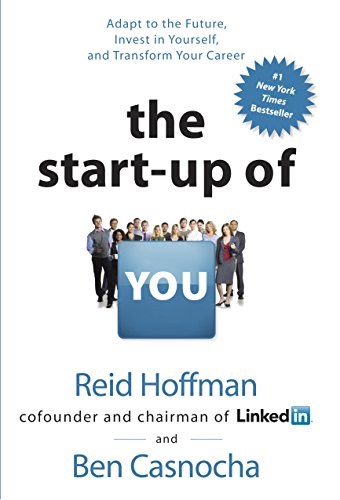The Startup of You, by Reid Hoffman and Ben Casnocha, is one of a few career-advice books that I have read over the past decade. In general, I do not like prescription books. Instead, I prefer to read books that are not solely concerned with pouring tons of advice over the readers; I like to seek out implicit wisdom from books and transfer it for my own usage gradually. This personal involvement possibly gives me more motivation to adopt the advice partially hidden in the pages. Because of the name Reid Hoffman, and his articles and podcasts that I enjoyed previously, I decided to give this book a go despite being skeptical.

Having read the book throughout one weekend, my evaluation is: on the back cover of the book, there is a price tag of 27 USD; this potentially is the best 27 USD investment in the startup of me, provided that I follow some suggestions from the authors. In summary, the main message is: the professional world has changed drastically over the last many decades, what worked in the past would not propel us to a successful new height anymore, we are fully responsible to adapt to the present and the future, to invest in ourselves professionally and take intelligent risks, and apply the entrepreneurial strategies to our careers.
I like the definition of permanent beta in the book: to always be starting; to forever be a work in progress.
This book prescribes how to:
- Develop a competitive advantage by combining our assets, our aspirations, and market realities.
- Use ABZ planning. “Plan A is what you are doing right now. It’s your current implementation of your competitive advantage. With a Plan A you make minor adjustments as you learn; you iterate regularly. Plan B is what you pivot to when you need to change either you goal or the route for getting there. Plan B tends to be in the same general ballpark as Plan A. Sometimes you pivot because Plan A isn’t working; sometimes you pivot because you’ve discovered a new opportunity that’s just better than what you’re doing now. In either case, don’t write out an elaborate Plan B – things will change too much after the ink dries – but do give thought to your parameters of motion and alternatives. Once you pivot to a Plan B and stick with it, that becomes your new Plan A……Plan Z is the fallback position: your lifeboat. In business and life, you always want to keep playing the game. If failure means you end up on the street, that’s an unacceptable failure. So what’s your certain, reliable, stable plan if all your career plans go to hell or if you want to do a major life change? That’s plan Z. The certainty of Plan Z is what allows you to take on uncertainty and risk in your Plans A and B.”
- Build a high-quality professional network and tap the network intelligence
- Find and create opportunities
- Appraise and take on intelligent risks
What to take or drop from this book is entirely up to the individual reader. Reading this book has brought some of my behaviors and thought patterns into close examination. It is a great read, worthy of my precious weekend.